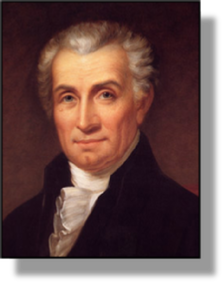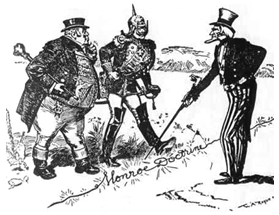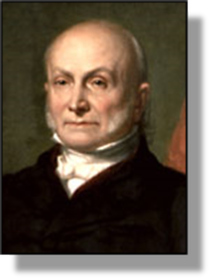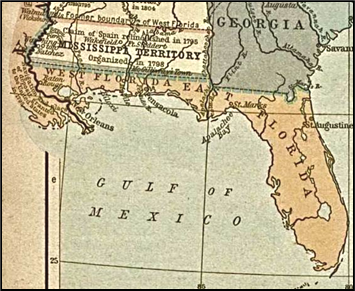


xxxxxThe Monroe Doctrine was proclaimed in 1823. By that year, as we have seen (1810 G3c), most of the colonial territories of Latin America had gained their independence from the Spanish, due in large measure to the efforts of freedom fighters such as O’Higgins and San Martin. In Europe, however, as we have seen, the Holy Alliance was bent on crushing revolutionary movements, and there was talk, notably at the Congress of Verona, that its leading members, Austria, Russia and Prussia should assist Spain in the task of re-
THE MONROE DOCTRINE 1823 (G4)
Acknowledgements
Monroe: by the American portrait painter Rembrandt Peale (1778-
 xxxxxThe Monroe Doctrine was proclaimed in 1823. By then, the Congress of Verona in 1822 and, to some extent, the earlier one at Troppau, had alarmed the American government. It feared that the declared intention of the Holy Alliance to uphold the old colonial regimes, -
xxxxxThe Monroe Doctrine was proclaimed in 1823. By then, the Congress of Verona in 1822 and, to some extent, the earlier one at Troppau, had alarmed the American government. It feared that the declared intention of the Holy Alliance to uphold the old colonial regimes, -
xxxxxAnd there was, too, at this time, another matter troubling the US government. In 1821 the Russian Tsar had announced that all the region north of the 51st parallel and stretching one hundred miles into the Pacific was to be regarded as Russian territory. Such a claim, extending, as it did, Russian influence down the Pacific coast from Alaska to California (then owned by Mexico), was rejected by the Secretary of State, John Quincy Adams, but it was thought that a stronger stand needed to be made.
 xxxxxIn response, therefore, to these conceived dangers, in December 1823 the US president, James Monroe, openly declared that any further colonial ambitions in the western hemisphere on the part of any European state would be seen as a threat to the peace and security of his nation. This declaration, which came to be known (much later) as the Monroe Doctrine, sent out a clear message, “Hands off the Americas!” In return for compliance, the United States pledged that, in its turn, it would not interfere in the affairs of Europe, nor in those of colonial territories already existing in the western hemisphere.
xxxxxIn response, therefore, to these conceived dangers, in December 1823 the US president, James Monroe, openly declared that any further colonial ambitions in the western hemisphere on the part of any European state would be seen as a threat to the peace and security of his nation. This declaration, which came to be known (much later) as the Monroe Doctrine, sent out a clear message, “Hands off the Americas!” In return for compliance, the United States pledged that, in its turn, it would not interfere in the affairs of Europe, nor in those of colonial territories already existing in the western hemisphere.
XXXXXXXXXXXXXXXXXXXXXXXXXXXXXXXXXXXXXXXXXXXXXXXXXXXXXXXXXXXXXXXXXXXX
xxxxxAt this particular time, it must be said, the United States was by no means powerful enough to enforce so ambitious a policy. However, the British supported the doctrine, and, as we saw at the Congress of Verona, were willing to use their considerable sea power to ensure that it was enforced. They took this line in the main because they feared that a resurgence of French and Spanish colonialism in the Americas would adversely affect their trade in the area, particularly with Latin America. Britain was fast becoming the world’s greatest trading nation, and the government wanted to keep it that way. Indeed, such had been Britain’s concern over this matter that it had been the British foreign secretary, George Canning, who had made the first move, suggesting a joint declaration by London and Washington on the lines of the Monroe Doctrine. But when the US government discussed the suggestion it was Adams -
xxxxxAs it so happened, the crisis passed and the Monroe Doctrine remained a paper threat. Its only immediate effect was to strengthen the rapport between the United States and the emerging republics of Latin America. It has no validity in US or international law, but nevertheless it has become a basic tenet of US foreign policy over the years, and was called upon by President Theodore Roosevelt during the early years of the 20th century. By then the US navy was well able to enforce it.
 xxxxxJohn Quincy Adams (1767-
xxxxxJohn Quincy Adams (1767-
xxxxxIncidentally, Adams’ purchase of Florida from the Spanish in 1819 was made the easier by the First Seminole War which took place over the two previous years. As we have seen, in this conflict between the US government and Creek Indians known as the Seminoles (“runaways”), American troops occupied Spanish territory in Florida, and this put pressure on the Spanish to give up their holdings in the peninsula in exchange for recognition of their sovereignty over Texas. ……
xxxxx…… Byxthe year of the Monroe Doctrine, a number of new states had been admitted into the United States. These included Ohio, Louisiana, Indiana, Mississippi, Illinois and Alabama. In 1919, however, a request by the territory of Missouri (acquired by the Louisiana purchase of 1803) to join the Union as a slave state brought opposition from the Northern non-
Including:
James Monroe and
John Quincy Adams

G4-



